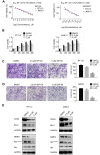Sulfated polysaccharide of Sepiella maindroni ink targets Akt and overcomes resistance to the FGFR inhibitor AZD4547 in bladder cancer
- PMID: 31545294
- PMCID: PMC6782013
- DOI: 10.18632/aging.102286
Sulfated polysaccharide of Sepiella maindroni ink targets Akt and overcomes resistance to the FGFR inhibitor AZD4547 in bladder cancer
Retraction in
-
Retraction of: Sulfated polysaccharide of Sepiella maindroni ink targets Akt and overcomes resistance to the FGFR inhibitor AZD4547 in bladder cancer.Aging (Albany NY). 2024 Sep 30;16(18):12652-12653. doi: 10.18632/aging.206104. Online ahead of print. Aging (Albany NY). 2024. PMID: 39348489 Free PMC article. No abstract available.
Abstract
Rapid appearance of resistance to fibroblast growth factor receptor (FGFR) inhibitors hampers targeted regimens in bladder cancer. In the present study, we evaluated whether SIP-SII, a sulphated derivative of the polysaccharide in Sepiella maindroni (spineless cuttlefish) ink used in traditional Chinese medicine, could attenuate resistance to FGFR inhibition in bladder cancer cells. In vitro assays indicated that SIP-SII reduced cell viability and migration, restricted cell cycle progression, and increased apoptosis in parallel with decreased AKT phosphorylation and downregulation of CDK4, MMP2, and Bcl-2 in RT112 and JMSU1 cells. Synergistic effects on cell viability were observed when SIP-SII was combined with the small-molecule FGFR inhibitor AZD4547. Specific Akt targeting by SIP-SII was suggested by the fact that neither Akt knockdown nor the selective PI3K inhibitor BKM120 enhanced the inhibitory effects of SIP-II, while expression of a constitutively active Akt mutant rescued SIP-SII effects. Furthermore, subcutaneous transplantation of RT112 xenografts confirmed the superiority and tolerability of combined SIP-SII and AZD4547 administration over monotherapy regimens. The present study thus provides pre-clinical evidence of the ability of SIP-SII to improve FGFR-targeted therapies for bladder cancer by inhibiting Akt.
Keywords: AZD4547; FGFR therapy resistance; Sulfated polysaccharide of ink Sepiella maindroni; bladder cancer; xenograft.
Conflict of interest statement
Figures






References
-
- Morales-Barrera R, Suárez C, de Castro AM, Racca F, Valverde C, Maldonado X, Bastaros JM, Morote J, Carles J. Targeting fibroblast growth factor receptors and immune checkpoint inhibitors for the treatment of advanced bladder cancer: New direction and New Hope. Cancer Treat Rev. 2016; 50:208–16. 10.1016/j.ctrv.2016.09.018 - DOI - PubMed
-
- Saka H, Kitagawa C, Kogure Y, Takahashi Y, Fujikawa K, Sagawa T, Iwasa S, Takahashi N, Fukao T, Tchinou C, Landers D, Yamada Y. Safety, tolerability and pharmacokinetics of the fibroblast growth factor receptor inhibitor AZD4547 in Japanese patients with advanced solid tumours: a Phase I study. Invest New Drugs. 2017; 35:451–62. 10.1007/s10637-016-0416-x - DOI - PMC - PubMed
-
- Bachir BG, Souhami L, Mansure JJ, Cury F, Vanhuyse M, Brimo F, Aprikian AG, Tanguay S, Sturgeon J, Kassouf W, Phase I. Phase I Clinical Trial of Everolimus Combined with Trimodality Therapy in Patients with Muscle-Invasive Bladder Cancer. Bladder Cancer. 2017; 3:105–12. 10.3233/BLC-160090 - DOI - PMC - PubMed
Publication types
MeSH terms
Substances
LinkOut - more resources
Full Text Sources
Medical
Research Materials
Miscellaneous

